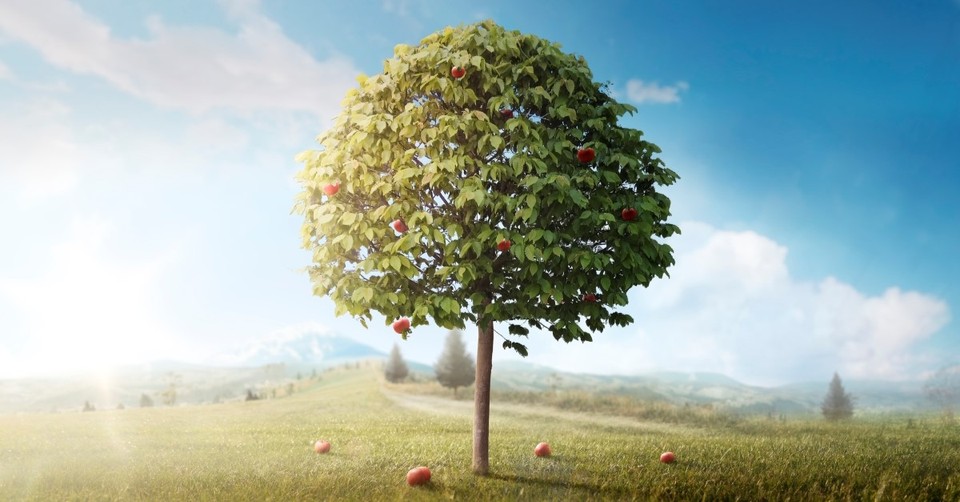Why Should We Remember the Christmas Hymn 'Jesus Christ the Apple Tree'?

Growing up, my family had a variety of fruit trees scattered throughout the yard, including Winesap apples, an old Southern favorite. Their sappy, sweet flavor made for delicious applesauce, with only a split-open apple and a spoon required.
The lyrics of “Jesus Christ the Apple Tree” read sweetly, with references to the beauty of Christ, resting under His shadow, and a thriving soul. But there’s nothing sappy about this hauntingly beautiful hymn, for in it, we find the true meaning of life. Thanks be to Jesus, our apple tree.
Do We Know Who Wrote “Jesus Christ the Apple Tree”?
The poem “Jesus Christ the Apple Tree” was first published under a different title, “The Tree of Life My Soul Hath Seen,” in 1761 in the London publication Spiritual Magazine. The writer was listed as R.H., who most readers presumed to be Rev. Richard Hutchins, a Calvinist Baptist pastor from Long Buckby, Northamptonshire.
In 1784, it appeared in the hymnal Divine Hymns or Spiritual Songs: For the Use of Religious Assemblies and Private Christians, a compilation by Joshua Smith, a lay pastor from New Hampshire.
Hutchins’ poem was set to music by several composers, although Elizabeth Poston, a British composer, is probably the best remembered. Her devotion to folk music is evident in the structure of “Jesus Christ the Apple Tree,” with its melodic overlapping, like a round, lending itself to a simple, easy-to-sing harmony. Her melody first appeared in The Cambridge Hymnal in 1967.
What Does It Mean that “Jesus Christ the Apple Tree” is a Carol?
Carols, celebratory songs of joy associated with faith, are traditionally sung at Christmastime, pointing to the birth of Jesus Christ.
While “Jesus Christ the Apple Tree” does not directly mention Jesus’ birth, many readers believe Hutchins intended the poem to become a carol. It may have been intended to redeem the pagan Christmas celebration of wassailing in apple orchards, singing to the spirits in hopes of a good harvest. Pagan imagery becomes redeemed with a Christian message—a common practice in Christian music throughout history.
Yet, there is a subtle but persuasive joy masterfully woven within the lyrics, a joy made possible because of Jesus’ birth, as seen in stanzas 2 and 3:
His beauty doth all things excel:
By faith, I know, but ne’er can tell
The glory which I now can see
In Jesus Christ, the apple tree.
For happiness I long have sought,
And pleasure dearly I have bought:
I missed of all: but now I see
‘Tis found in Christ the apple tree.
The lyrics above speak to a heart longing to know the deeper meaning of life. We search but miss it all until we find it in “Christ the apple tree,” who offers a meaningful life rooted in this glorious truth:
Jesus left His heavenly throne and became man, living among us, seeing the unseen, bringing healing spiritually, emotionally, and physically. He lived a perfect, sinless life, as only He could, and became the sacrifice for our sin, bearing the weight of the world’s sin on a wooden cross. He died but arose in three days to victory, crushing every ploy of the enemy, beginning with a piece of fruit in the Garden of Eden. Through Jesus’ resurrection, we are set free from eternal death and the penalty of sin and set free to live an abundant (purposeful, content, and joyful) life.
We were blind, but now we see that all of life, the unspeakable beauty and value of our faith, is found only in Christ the apple tree.
Does “Jesus Christ the Apple Tree” Reference Any Bible Verses?
It’s believed the carol alludes to at least two Bible verses.
In English translations of Song of Solomon 2:3, an apple tree is a metaphor for a Bride’s admiration for her husband: “Like an apple tree among the trees of the forest is my beloved among the young men. I delight to sit in his shade, and his fruit is sweet to my taste.” Apples were not known to grow in ancient Judea, the passage refers to another fruit (maybe apricots or pomegranates). Still, the use of apples to symbolize admiration or nourishment has become common in Western culture.
As Christ-followers, the Bride of Christ, we adore Jesus, our apple tree, who is far above any tree of the forest, for He is above all others and worthy of praise. We delight in His presence, and in this communion, He spreads over us as a tree branch, providing shade and refreshment, for His goodness is sweet to our sight and taste (Psalm 34:8).
Another Bible verse, Genesis 2:9, includes the two most recognized trees in scripture, the tree of life and the tree of the knowledge of good and evil. In Genesis 2:16-17, God commands Adam to enjoy eating from any tree in the Garden except the tree of the knowledge of good and evil. We know how the story ends. The serpent tempted Eve. She took a bite of the fruit hanging from the tree and handed it to Adam, and he also took a bite (Genesis 3).
But Jesus, our Messiah, came to make right what Adam and Eve had done wrong in disobeying God’s clear command. They wanted to be like God, but instead, became sinners in need of a Savior. Only the perfect Sacrifice lifted on a tree and raised three days later could transform a tree of death into a tree of life. Jesus Christ, the apple tree trumped the enemy’s attempt to bring eternal death to humanity, providing eternal fruit that will never rot or mold as we seek Him above all other “trees of nature.” We see this idea explored in the first stanza:
The tree of life my soul hath seen,
Laden with fruit and always green:
The trees of nature fruitless be
Compared with Christ, the apple tree.
What Theological Themes Does “Jesus Christ the Apple Tree” Discuss?
Satisfaction is found only in Jesus. The world (trees of nature) offers satisfaction to every supposed need: Super-sized meals, faster internet, a more efficient car, dating apps, and viral popularity, to name a few. They may offer temporal satisfaction, but only Jesus “satisfies the thirsty and fills the hungry with good things” (Psalm 107:9). We wear ourselves out searching for things, activities, and people to fill a space they never can. Come, sit, and rest. As the third stanza reminds us, we must find true fulfillment in the person of Jesus Christ.
For happiness I long have sought,
And pleasure dearly I have bought:
I missed of all: but now I see.
‘Tis found in Christ the apple tree.
Delight is found only in Jesus. Like the wife enamored with her beloved in Song of Solomon 2:3, God wants his people to find extraordinary delight in Jesus, for He is worthy. Psalm 37:4 says, “Delight yourself in the LORD, and he will give you the desires of your heart.” “Trees of nature” may stand tall and offer beauty. However, only Jesus, the apple tree, delights from within, bringing nourishment and refreshment to the soul, cultivating fruit that delights with every bite. We see this idea especially underlined in the fourth stanza:
I’m weary with my former toil,
Here I will sit and rest awhile:
Under the shadow, I will be
Of Jesus Christ the apple tree.
Redemption is found only in Jesus. God mercifully banished Adam and Eve from the Garden of Eden when their sin was exposed. If they remained in the Garden and ate from the Tree of Life, they would live forever in their sinful state with no hope of redemption—for them and all of humanity. Jesus, our Redeemer, brings life where there once was death, becoming the tree of life to every person who believes. (John 3:16). The fifth and final stanza takes us directly to that idea that death becomes life in Jesus:
This fruit doth make my soul to thrive,
It keeps my dying faith alive;
Which makes my soul in haste to be
With Jesus Christ the apple tree.
A Prayer Thanking God for Sending Jesus
Heavenly Father, thank You for bearing the grief of sending your only Son, Jesus Christ, who began His earthly life in a wooden manger and died with the weight of my sin and the sin of the world on a wooden cross. In Christ, I now live in the “shade” of His resurrection power, bringing true fulfillment in all life. How could I ever ask for more? Thank You, Jesus, my apple tree. Amen.
To read about more Christmas carols and other classic hymns, check out these articles:
What Can We Learn about God from the Hymn 'Servant King'?
Top 12 Old Hymns and Classic Christian Songs
What Can We Learn from the Hymn 'In Christ Alone'?
25 Christmas Hymns to Celebrate the Birth of Jesus Christ
What Can We Learn from the Hymn 'Safe in the Arms of Jesus'?
Photo Credit:©GettyImages/RuslanShevchenko


Originally published April 09, 2024.







